Texture Synthesis
Texture Generation Using Dart-Throwing Method
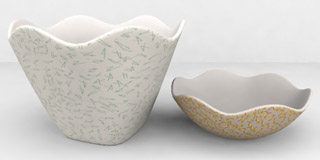 |
This research aims to effectively generate non-periodic textures comprised of discrete elements having various densities. For this, we use the dart-throwing method that places elements within an exclusive, user-specified region and prohibits overlapping of the regions of these placed elements. Changing the exclusive regions controls the densities of textures. For effective placement, our method involves two steps: placing elements sparsely and then placing additional elements in the gaps between the placed elements. |
Characterization and Reconstruction Method for Pore Pattern on Leather Texture
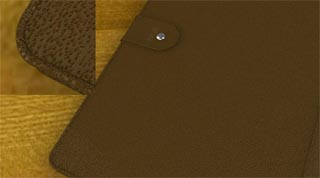 |
This research proposes a characterization and reconstruction technique for pore pattern on leather texture. We first introduce a layered geometric model for pore pattern on leather texture. Next, we analyze data of leather texture statistically in order to extract a few parameters for representing the leather geometry. Then, the method reconstructs the leather texture based on the layered geometric model using the captured parameters. |
Leather Texture
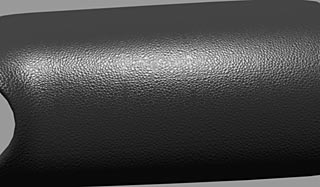 |
This project introduces a method for generating leather texture by means of particle simulation and blobby model. The method first generates a cell arrangement pattern using a 3D particle model, and then the detailed surface geometry of each of the cells applying a blobby model. A user can create various types of realistic looking leather textures with ease by simply choosing a cell arrangement type, and directionality which assigned partially, along with the control parameters. |
Organic Texture
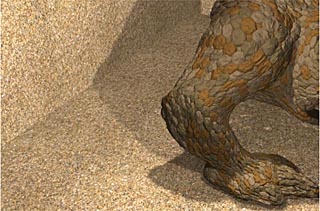 |
This project presents a method of generating organic textures using an anisotropic meshing technique. A pattern of packed cells for a given area is generated by performing particle simulation with proximity-based forces. The organic texture is then obtained by generating a 3-D geometry for each cell with the subdivision surface method and then applying fractal noise to create a detailed surface geometry. In this method, the boundary shape of the surface, restriction lines, directionality of cells, the swell value of the cells, and so on are specified as input geometric data, along with attribute data such as the roughness, color, and optical attributes of the cells. The proposed method automatically generates a realistic looking organic texture, especially in a reptile skin, for an arbitrarily shaped area with much lower computational cost than previous methods. |
Pavement
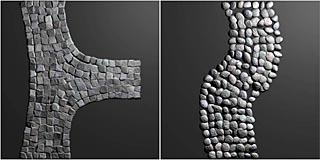 |
This project proposes a method of generating pavement textures using the square packing technique. A packing pattern for a given area is generated by solving the equation for the forces acting on scattered particles. A pavement texture is then obtained by generating stone textures for each packing area. |
Texture Generation Designed by Skeleton Lines
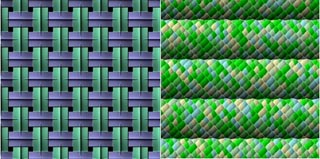 |
A method is given for synthesizing texture by using a set of skeleton lines and attribute functions. The attributes of each point in a texture, such as color, bump, and optical attributes, are calculated by applying attribute functions to the definedskeleton lines. This method has the following three merits: First, combining a set of skeleton lines and attribute functions allows a variety of textures to be obtained. Second, this method has flexible data definitions; the skeleton data can be defined not only by means of mathematical functions with control parameters, but also graphically by means of an input device, such as a tablet or mouse. Third, the user can preview a texture together with its skeleton lines. This is useful, because the texture generation procedure takes a significant amount of time. |
Stone Wall
 |
This project proposes a new method of generating stone wall patterns as a specific case of a generalized texture generator. The advantage of the method is that it allows the user to generate a variety of stone wall patterns by specifying a few simple parameters. We have applied it to a visual simulation system in order to represent such stone textures as walls, pavements, and steps. We also give some illustrated examples of its applications. |
Materials
A Shading Method for Surface Detail
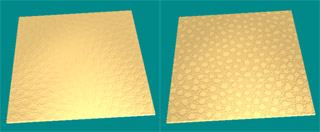 |
This research proposes a shading method for surface detail by means of an ambient occlusion method. This method adds realism to surface dents or grooves based on bump mapping without deforming surface geometry. As a result, the proposed method offers a better perception of the three dimensional surface shape. |
An Effective Bump Rendering Method Considering Level-of-Detail
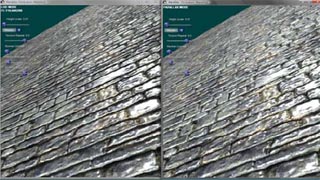 |
This research proposes a method of effective material representation considering human visual characteristics. This method adapts human visual characteristics to switch three techniques, parallax occlusion mapping, bump mapping and texture mapping, corresponding to objectfs level of detail. As a result, the proposed method improves drawing speed between 10-20%, comparing with the performance which applies simply a parallax occlusion mapping. |
Gold Leaf
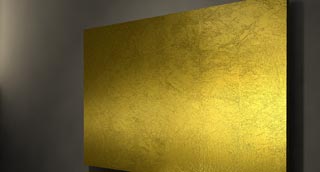 |
Southern Ishikawa area research unit, which has been selected as one of the promotion of science and technology on city area project, is developing a visual simulation method for traditional craft materials. This project presents a method for representing gold leaves faithfully using Bidirectional Reflectance Distribution Function (BRDF) and surface bump data of materials. In this method, the color variation to gold leaf by the angle of incidence of light is confirmed and it can be perfectly reproduced. In addition, a peculiar wrinkle to gold leaf is also expressed. |
Japanese Lacquerware
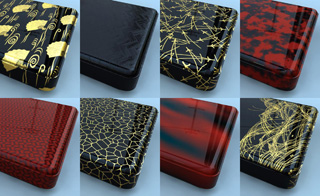 |
This project proposes a method for representing gold leaf and Japanese lacquer faithfully using Spectral Bidirectional Reflectance Distribution Function (S-BRDF). This paper also describes a me-thod for laying out craft materials and for generating tearing patterns of gold leaf. |
Creation Support
A Procedural Modeling of Various-Sized Rocks on the Ground
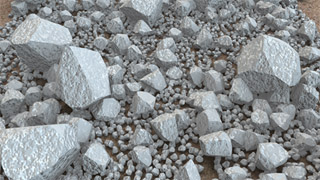 |
We propose a method for generating and placing rocks of various sizes. Previous methods did not control sizes of rocks. To improve the modeling, our method generates rocks by a graph synthesizing some Voronoi diagrams. Each Voronoi diagram is constructed using a set of isotropic sites calculated from Poisson-disk distribution. Each diagram contains uniform-size cells, and the diagram can specify the size of its cells. To construct a graph from these diagrams, a synthesis exclusively selects some cells from each Voronoi diagram, in descending order of size. A triangulation generates a mesh with additional vertices in each cell of the synthesized graph, and then rock shapes are formed by swelling the mesh in three-dimension to form various rock shapes. This procedure alters the sizes of rocks, and can generate more realistic scenes. |
Interactive Procedural Modeling of Pebble Mosaics
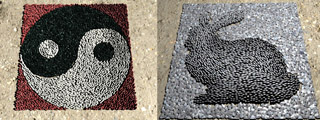 |
In this project, we focus on the generation of pebble mosaics to achieve the distribution of numerous pebbles while maintaining distribution controllability. Existing research on rock modeling and digital mosaics has not focused on user-specified arrangements, whereas in this work, we present an interactive method for generating pebble mosaics. This is achieved through designing an underlying tensor field that specifies the pat- tern of pebble arrangement. The experimental results show that a realistic visual quality is obtained using our proposed method. |
Rule-based Modeling of Library
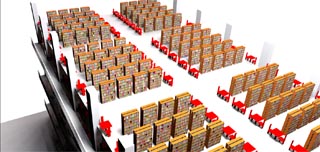 |
This project proposes a combination approach of rule-based modeling and procedural modeling to create books and bookshelves for various scenes. Using our approach, we can give the generated model more broad variations, with parameterized variables by employing the procedural method, and with weighted rules by employing the rule-based method. In addition, rules composed with hierarchical considerations give the modeling approach more broad variations. Furthermore, considering repetitive patterns of layout of bookshelves occurring in scenes such as libraries and bookstores, we can easily change the details. This saves costs to produce a scene similar to but slightly different from the original scene. |
Automatic Generation Method for Processing Plants
 |
A processing plant consists of massive parts including tanks, pipelines, processing columns, frames, and so on. This paper reports a method for automatically generating the landscape of a processing plant from a 2D sketch input and some control parameters. This is difficult to implement with conventional procedural methods. The results show that the landscapes of a processing plant are satisfactorily represented, while some detailed parts, such as valves, steps, and branching pipelines, are not generated. The generated 3D geometric data are useful for constructing background scenes in movies and video games, and are also applicable for pre-visualizing a landscape to construct a processing plant. |
Generation of Tree Distribution with Multi Layer Structure
 |
This research enables a CG designer to create forests with multi layered structures, which are specified by image data. A user can design a forest vegetation interactively by means of editing 2D image. And then, 3D forest models are generated after the vegetation simulation. |
Design Support System for Kaga-Yuzen
 |
This project proposes a support tool for designing kimono patterns. Kimono patterns are controlled by two rules, "flow" and "hierarchy"; the rule of "flow" controls the pattern arrangement, and the rule of "layered structure" manages the layer structure of pattern. The proposed system supports design of kimono patterns, considering these two rules.@The system also applies L-System to express ornamental patterns of plants to appear in kimonos semi-automatically. It is possible for people who do not have good design skills to obtain an intended kimono pattern easily by using this system. |
NPR
Mosaic Image Generation from 3D Models
 |
This method generates a mosaic image from 3D models. This approach has two advantages; 1) It is possible to render a mosaic image from multiple viewpoints. 2) The resulting image represents three-dimensional features, such as surface ridges and wrinkles, accurately. These features are sometimes not depicted in 2D images, and it is hard to extract them from the source image. |
Comic-like Rendering
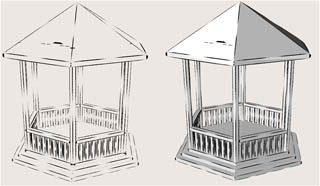 |
This project proposes a method to render a comic-like image from 3D model. The system extact the edges from specified 3D models, and then these edges are coverted into comic-like pen strokes. |
Image Processing
Algorithmic Painter
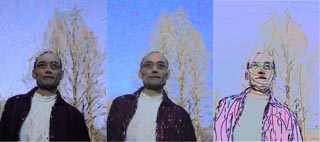 |
This project proposes an algorithm which can produce various styles of painting from source photos. Algorithmic Painter is created by enhancing Synergistic Image Creator, is a painterly rendering method, to be highly expressive but to still reserve the essential characteristics of the source photo. To achieve this, our method extracts three types of image segments automatically from a source photo by newly proposed classification method: edge areas, homogeneous areas, and highly contrastive areas. Next, each obtained image segment is converted into a brushstroke. Finally, the target picture is rendered by assigning a color to each pixel. Furthermore, this method can control the curvy shapes of brushstrokes, so that the obtained image can not only incorporate various artistic touches but also natural touches. (Joint project w/ Prof.Kasao @ Tokyo Polytech Univ.) |
Hairstyle Simulation
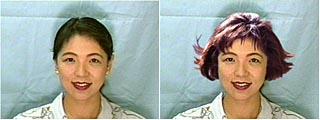 |
This project presents a hairstyle simulation system that automatically fits a stored hairstyle image to a captured face image. The target hairstyle image is adjusted in accordance with face feature data, and is then transformed by an image warping operation to fit the face image. |
Animation
Free Fall Motion Synthesis
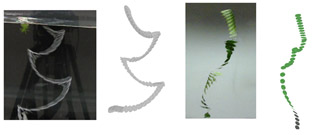 |
This research proposes a framework that generates free fall motions for the object within a still fluid. We introduce a new motion synthesis approach where six characteristic motion prototypes of free fall are defined and synthesized, and then the motion trajectory is specified form free fall motion graph. We automatically create motion sequences using trajectory search tree and pre-computed trajectory database. The proposed approach can produce realistic and controllable free fall motion that could be applied in many different applications, including virtual reality, game and other entertainment productions. |
Kansei
Font Selection Using an Interactive Genetic Algorithm and Similarity Search
 |
Our method provides a simple and effective font selection process based on the users' KANSEI. In several experimental evaluation, we affirm that our method is effective in searching for a desired font, helping users obtain a font suitable for an alphabetic character and non-alphabetic character. The aim of this study is to develop a method to help users find a suitable font without displaying all the choices. |
A Study on Gender-Kansei of Three-Dimensional Geometric Shapes
 |
The aim of this study is to investigate people's perception on gender of 3D shape in terms of semantic association such as "feminine" or "masculine". Three elements of 3D shape were considered to investigate its gender, first is variable base, second is variable sweep, and third is variable axis. In this paper we observed the eRect of variable base on perceiving gender kansei of 3D shapes as an extension of our earlier work. To assess base-variance of 3D shape, we examined whether convexity and concavity of base in the context of sharp and curved forms. Results of our psychophysical experiments will be very important and helpful in the kansei-driven design. |
Interactive Media
Extreme Can Crusher
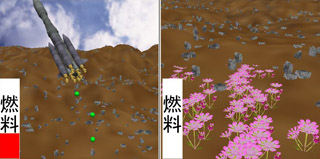 |
This application motivates a user to crush an empty can based on fun theory. The system measures a strength of pressing an empty can, and the measured data are used to launch a rocket. The launched rokect sow seed in the soil, and the flowers blossom. The color of flower is related to the color of cruched can. The user enjoys crushing cans playing the game. |
Papermaking from Cloud
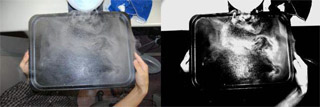 |
This system allows a user to make a paper from clouds. A user scoops up clouds which is exhausted from a smoke generator with a pad. The image of scooped clouds on the pad is captured by a CCD camera, and then the user shakes the pad to control the pattern of smoke. Finally, the pattern of smoke is converted to the fibers of an intended paper. |
Spider Hero
 |
This application allows someone to experience to use the superpower. We focused attention on Spiderman as one of the famous super heroes. In this application, the user can jump from one building to another by using a spider web and being stuck to it like Spiderman. The most important thing is the method of the pulling force feedback in this application. Hence, we made a novel pulling force feedback system by means of vaccum device. By this system, the user feels the pulling force. The aim of this application is to give the user the enjoyment of using superpower. |
Face Search
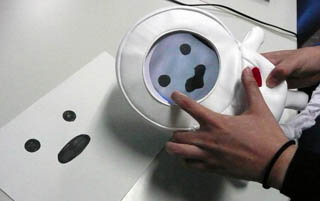 |
There are a lot of face-like objects and materials in our living@environment. If things look like faces, we can interpret the things as if they were living things. However, such faces are only objects. Therefore, they canft create facial expressions and speak. If those faces could move and speak, it would be a very amusing discovery and experience for many people, especially children. |
Landscape Bartender
 |
This project presents a system that generates landscapes using a cocktail analogy. With this system, users generate landscapes by combining "ingredients." Users select a bottle containing the intended landscape element and pour an appropriate amount of water into a shaker. The amount of water used from each bottle determines the ratio of landscape elements. The relief of the surface and the position of each element are changed by shaking the shaker. This system provides the enjoyment of creating onefs own favorite scenery. |
Witch's Cauldron
 |
This project presents a novel interactive application that realizes fracture of virtual objects by stirring them with a wand. This application calculates collision force for each object, and an object breaks apart when it collides hard with others. The player crashes the objects interactively with a feeling of haptic sensation, and watches computer-generated imagery of fracture simultaneously. |
Interactive Fountain
 |
This project presents an interactive system which controls fountains so that wind generated by a fan blows off spring water.@The system consists of seven fountain units; each unit has a PC-controlled water pump and nine full-color LED lights. The lighting color and expelling speed of water are controlled with motion of player's fan. |
Kyukon
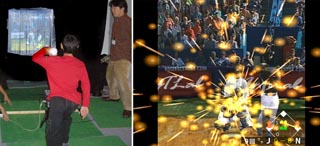 |
This project presents two virtual reality applications that give real baseball experience by means of wireless acceleration sensor and strip screen. These applications have more direct and intuitive input method than traditional baseball video games. Wireless acceleration sensor allows us the same motion as real pitching motion. Strip screen connects the real world where the player and the real ball are and the virtual world where the virtual ball and virtual actors are seamlessly. |
Tomte
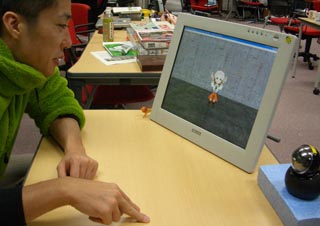 |
Tomte is a body sensory style VR application, which captures the player's hand motion as an input, to control the virtual character, in the theme of "Puppet Play". Tomte can be played in real-time, controlling the virtual character in many ways. The system renders the character animation which is controlled by the player's hand motion captured with the USB camera. This application realized a novel method for character animation that enables to play it intuitively, and also no need to wear any device. Tomte proved the possibility of controlling the computer without a device, and also an application of the gesture recognition. |
TonTon
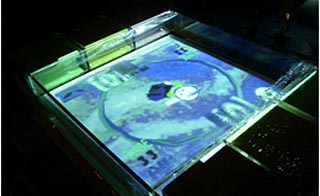 |
This project introduces a match-up style VR application in the theme of Paper-craft Sumo using displacement data. The VR system captures the waving motion data, and calculates the movement of the Paper-craft Sumo Wrestlers, which are projected onto the floating screen on water, using those data. The system captures the playerfs motion data as displacement values by means of the distance sensors, and the data are used for their interaction model. New body sensory style application is implemented by using intuitive and robust interaction methods. |
CryptiLight
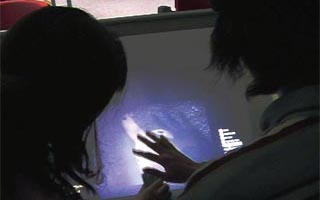 |
This paper introduces a digital image editing system that can be operated intuitively. In this system, the target image is projected on a back projection screen, and the user retouches the image using an infrared lighting device. The quantities of light on the screen are captured by means of a CCD camera. Then, the image is edited according to the amount of infrared light. This system makes it possible to process images directly and intuitively. Moreover, this method has the advantage of allowing simultaneous editing by two or more people. |
ViewFrame
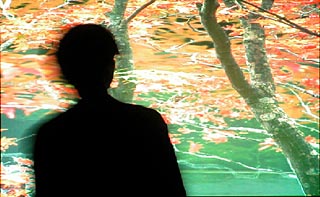 |
An interactive image viewer, gViewFrameh, by means of image-based face detector without marker is proposed. In this paper, the concept, gwindow-though realityh, is introduced. A window in a room is replaced with a LCD or another flat screen, and this system displays a view-depended CGI scenery that would be seen from an observer. This system is required to react to userfs action in real time; therefore the image processing is implemented by means of pixel-shader functions for GPU to accelerate the process. This system makes it possible to recognize the depth of image and three-dimensional shapes easily by natural man-machine interaction. |
UoQ / UoQA
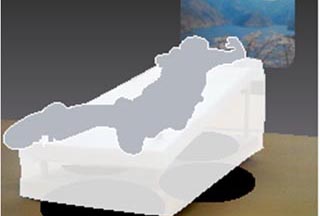 |
What will be affected if the scenery seen with a walk is replaced by the act of swimming? This project proposes a method of replacing various vision experiences accompanying such body movement by means of computer. Reference light is reflected with the reflector with which both arms were equipped, and the reflected light is observed with the CCD camera. Next, the motions of arms are analyzed by means of image processing, and then the speed of video is controlled in accordance with change of the motion. The posture of the body of equipment is also controlled in accordance with change of the motion by means of air blowers. Therefore, an audience may feel swimming in the video. |
Natural Objects
Modeling Trees with Rugged Surfaces
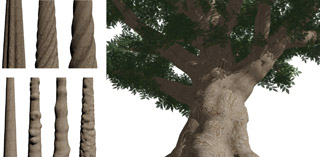 |
In this study, a method for modeling trees with rugged surfaces by simulating tree growth is proposed. The phenomena of cell division is considered for simulating tree growth. There are two types of cells that affect the growth of trees, namely, the apical meristem cells and the cambium cells. The former cells lie at the apex of a branch and are responsible for the extension of the branch. The latter cells cover the surface of the tree and are responsible for its lateral growth. Further, knots are generated by unusual and uneven growth of the cambium cells. To simulate these phenomena, a tree is modeled as a polygon mesh which grows by displacing the vertices of the mesh. Each vertex acts as an apical meristem cell or a cambium cell. The tree growth is defined by an L-System. Subsequently, tree models with rugged surfaces, such as those including knots, are generated. |
Mountain and Cloud
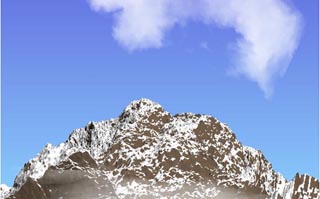 |
The mountainous shapes and clouds are generated from two dimensional contour lines. The shapes are generated by means of fractal theory. |